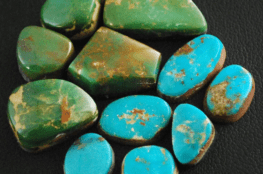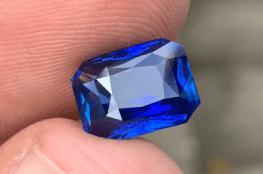
Introduction
Opal, a gemstone that has been treasured for thousands of years, is renowned for its striking play of colors known as “play-of-color.” This mesmerizing phenomenon is due to the gem’s unique internal structure, which consists of countless tiny silica spheres that diffract light and create a spectrum of colors. Opal’s rich folklore, coupled with its captivating beauty, makes it a gem that is both intriguing and highly sought after.
The Formation of Opal
Opal is an amorphous form of silica, similar to quartz, but with a water content ranging from 3% to 21%. It is essentially formed from a solution of silicon dioxide and water. As water seeps through the earth, it picks up silica from sandstone and carries it into cracks and voids. Over millions of years, the water evaporates, leaving behind a silica deposit. This sedimentary stone is formed when dissolved silicates are deposited as microscopic spheres.
Types of Opal: Precious vs. Common
Precious Opals
Precious opals, also known as “noble opals,” are characterized by their vibrant play-of-color. When the silica spheres are uniform in size and shape and are neatly stacked, they diffract light, creating this phenomenon. The colors seen in an opal’s play-of-color depend on the size of the spheres and the angle of viewing.
Common Opals
Common opals, on the other hand, have random sizes and arrangements of silica spheres. They do not exhibit play-of-color and can have an opaque or glassy appearance with a waxy luster. Common opals come in a wide range of colors and are often fluorescent.
Varieties of Precious Opal

- Black Opals: Dark body color that enhances the vibrancy of the play-of-color.
- White Opals: Light body color with play-of-color.
- Fire Opals: Transparent to translucent with a warm body color, usually orange, red, or brown.
- Boulder Opals: Form within ironstone and show dazzling play-of-color backed by brown ironstone matrix.
- Crystal Opals: Transparent to semi-transparent with a rich play-of-color.
- Water Opals: Transparent or colorless body that may have play-of-color.
- Milk Opals: Translucent, milk-white stones that may also have yellowish or greenish color.
Opalized Fossils and Assembled Opals
Opals sometimes form in the shapes of wood, bone, and seashells, effectively replacing these organic materials. These are known as opalized fossils or pseudomorphs. Additionally, gem cutters can assemble thin pieces of opal into doublets and triplets for use in jewelry.
Sources of Opal
Australia dominates the opal market, accounting for 95-97% of the world’s production. Other notable sources include Ethiopia, Mexico, Brazil, the United States, Indonesia, and the Czech Republic. Each source is known for specific types of opal.
Value, Grading, and Enhancements
The value of an opal is determined by its type, size, body color, transparency, and the quality of its play-of-color. Black opals are generally the most valuable. Common enhancements include oil, wax, or plastic impregnation to improve appearance. However, some enhancements may not be durable.

Caring for Opal
Opals are delicate and require careful handling. They are sensitive to temperature changes and can be easily scratched. It is advisable to store opals in a sealed plastic bag with adamp piece of cotton to prevent dehydration. Opals should be kept dry and away from chemicals, as they contain water and can be damaged by heat or chemicals. For opals used in jewelry, especially rings, it is recommended to use protective settings or reserve them for occasional wear.
Detecting Faux or Imitation Opals
It’s essential to distinguish between synthetic and imitation opals. Synthetic opals are created in labs and closely resemble natural opals and have a distinctive lizard skin formation in them, while imitation opals are usually made from plastic or glass and only simulate the appearance of opals. Plastic imitations can be probed with a sharp needle, and they don’t phosphoresce. Glass imitations typically contain glass bubbles and swirl marks. Knowing the specific gravity and refractive index can also help in identifying natural opals.
Conclusion
Opal is a gemstone that exudes elegance and mystique with its vibrant play-of-color. With its various types and sources, opal continues to be a beloved gem for many. However, due to its delicate nature, it requires special care. Whether you are a collector, a jeweler, or someone who appreciates the beauty of natural gemstones, opal’s enchanting array of colors and its rich history make it a gemstone that is truly one of a kind.


